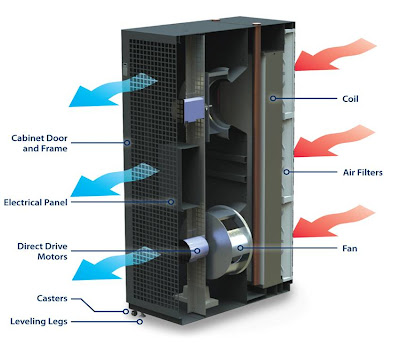– Marc Caiola, vertical marketing manager for Pentair Technical Products (http://pentairtechnicalproducts.com/), says:
Due to rising energy costs, coupled with increasing power densities of next generation data center equipment, data center and IT managers should rank high-efficiency cooling as a top priority. An effective cooling solution significantly contributes to maximizing Power Usage Effectiveness (PUE) and Data Center Infrastructure Efficiency (DCIE) performance within the data center. PUE and DCIE are similar, but inversely related, performance metrics. PUE is a measurement of how efficiently the data center and IT infrastructure utilizes its power (PUE = Total Facility Power / IT Power), whereas a low PUE ratio indicates a highly efficient data center environment. DCIE is a performance improvement metric used to calculate the energy efficiency of a data center (DCIE = IT Power / Total Facility Power) – a high DCIE percentage indicates a highly-efficient data center environment. Thus, low PUE and high DCIE performance measurements go a long way to dramatically reducing the energy costs associated with operating a data center.
In today’s technology-dependent world, a reliably operating data center is a core necessity for small and large businesses alike. Without properly running network systems, most companies simply cannot run at all. For many companies, the most significant challenges are adaptability and scalability – addressing both current and future thermal management requirements. Thus, data center cooling solutions need to be flexible and scalable while minimizing total-cost-of-ownership (TCO) challenges over data center infrastructure lifecycle.
Data Center and IT Managers can overcome challenges by conducting an initial energy audit. The energy audit should provide a comprehensive summary related to how much electricity is consumed by the data center and IT infrastructure. In many cases, data center and IT infrastructure energy usage can range between 8 percent and 30 percent of overall enterprise energy consumption. Additionally, managers should calculate watts-per-rack cooling requirements while identifying (and mitigating) hot-spots in order to isolate cooling issues and maximize cooling efficiency within the data center environment. High efficiency precision cooling, such as the POWERLEAN, can mitigate current cooling challenges while providing a future proof solution for data center cooling. POWERLEAN provides supplemental cooling and can be deployed at a close proximity to hot running equipment – such as high density servers – without the need to add (or modify) HVAC or CRAC cooling systems.
Data center and IT managers should address key questions when addressing cooling concerns within the data center environment. Some examples include:
- What is the cost/benefit associated with deploying the cooling solution vs. adding to existing cooling plant?
- What is the cooling medium – air-to-air, air-to-water, other?
- How much airflow (CFM) does the cooling solution deliver?
- How will the cooling solution improve our current PUE and DCIE?
- What is the power consumption of the cooling solution – watts/hr?
- What is the annual operating cost of the cooling solution?
- What is the noise level – how much additional noise will this add to the room?
- What is the maintenance schedule – how much (and how often) maintenance is required?
- How the cooling solution is installed – overhead, in-row, in-room, in-rack, etc.?
- Price is always an important factor, but it is recommended to factor the Total-Cost-of-Ownership throughout the life of the cooling solution as a part of the initial price.
POWERLEAN is a highly efficient In-Row or data room cooling solution that can be deployed in small to large data centers, wiring closets or server rooms.
POWERLEAN is an ideal solution for the following appications:
- Cooling rows of racks in hot aisle/cold aisle raised and unraised floor data centers
- Cool a modular data center with evolving requirements
- Cool rack equipment with higher than average densities or a mix of densities
- Cool “hot spots”
- Cool a small data room without having to install a CRAC system
- Reduce energy consumption
- Reduce noise levels (60 dBA at 1.5 meters)
High Efficiency, with low total cost of ownership – POWERLEAN provides considerable reduction in annual operating costs versus competitive in-row coolers. Furthermore, utility rebates may be available based on energy savings, and users are encouraged to check with local utility companies to determine if rebates are available. See cost saving comparison matrix (Table 1) – please note that energy costs will vary by state.




